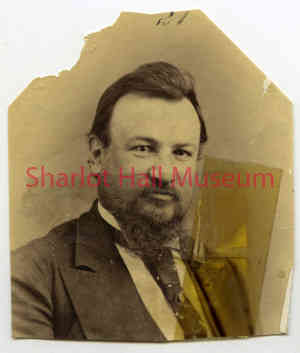M.G. Samaniego
details
Unknown Unknown 1700-1563-0000.jpg PO-1563 B&W 1700-1563-0000 1700-1563-0000 Print 3x5 Historic Photographs 1880s Reproduction requires permission. Digital images property of SHM Library & ArchivesDescription
M.G. Samaniego (b.1844 - d.1907) was born in Bapispe, Sonora, Mexico on July 26, 1844. His mother was Ysabel Luna de Samaniego, born in Mexico in 1815 and Bartolo Samaniego, no birth date or birthplace found.
Mariano G. Samaniego was a pioneer Tucson freighter, rancher and legislator. After his father Bartolo died in 1850, his mother Ysabel moved the family to La Mesilla, New Mexico, where Mariano became a naturalized United States citizen under the treaty terms of the Gadsden Purchase.
Samaniego graduated from St. Louis University in 1862.
In 1864, he began a freighting business which supplied army posts as far east as the
Missouri River.
Samaniego married Dolores Aguirre in March, 1868.
Indian raids were frequent in Samaniego’s early career, earning him a reputation as a fearless Indian–fighter. Two of his freight trains were attacked by Apache Indians near Las Cruces, New Mexico in April, 1868 and September, 1868. His losses in stock, wagons and supplies totaled nearly $11,000, for which he filed Indian Depredation Claims against the United States government in 1891.
Samaniego moved to Tucson in 1869 where he continued the freighting business, going as far west as Yuma in 1876. He also operated the stage line between Tucson and Oro Blanco, and he held the mail delivery contract to Oro Blanco, Mammoth, La Osa , Arivaca, and Oldglory.
In 1881, his brother Bartolo was killed by Indians in Cedar Springs, Arizona, while freighting for Samaniego. Shortly thereafter, Samaniego sold his contract to carry army supplies and devoted more time to raising cattle, placer mining, investing in land, and operating the stage line. His property holdings included the Canada del Oro Ranch and the Rillito Ranch near Tucson, placer mining claims in Pinal and Pima counties, and over fifty acres of property in and around Tucson.
Samaniego had a keen interest in developing Tuscon and Arizona. He owned the land that furnished Tucson’s first water supply, and he invested in the Rillito and Santa Cruz Valley Canal & Irrigation Company.
A strong advocate of higher education, he was appointed a University of Arizona regent in 1886.
In politics, Samaniego represented Pima County in the 9th, 11th, 16th, and 18th
Territorial Legislatures (1877, 1881, 1891, 1895). He became Pima County’s first
assessor in 1886, and was elected to the Tucson City Council in 1891. He was also a
member of the Pima County Board of Supervisors from 1890 to 1901, serving as Board Chairman in 1901.
Samaniego belonged to several organizations. He was an elected officer of the Arizona Pioneers’ Historical Society in the 1890’s, serving two terms as President. He chaired the Territorial Miners’ Convention in Phoenix in 1898 and was a charter member of the Arizona Cattle Growers’ Association in 1904. He also helped to organize the Spanish-American Alliance, becoming president of the organization in 1901.
Handwriting on photograph reads: "M.G. Samaniego".
Samaniego died on August 8, 1907 in Tucson, Arizona. He was buried in Holy Hope Cemetery and Mausoleum in Tucson.
Sources: Mariano G. Samaniego Family papers, MS 0706, Arizona Historical Society-Tucson; findagrave.com; Albuquerque Journal 8-16-1907; Arizona Weekly Citizen 12-29-1883, 7-26-1884, 5-6-1886; Arizona Daily Star 1-5-1892, 9-26-1897; Arizona, Pima County, Voting Records, 1876-1926.
Purchase
To purchase this image please click on the NOTIFY US button and we will contact you with details
The process for online purchase of usage rights to this digital image is under development. To order this image, CLICK HERE to send an email request for details. Refer to the ‘Usage Terms & Conditions’ page for specific information. A signed “Permission for Use” contract must be completed and returned. Written permission from Sharlot Hall Museum is required to publish, display, or reproduce in any form whatsoever, including all types of electronic media including, but not limited to online sources, websites, Facebook Twitter, or eBooks. Digital files of images, text, sound or audio/visual recordings, or moving images remain the property of Sharlot Hall Museum, and may not be copied, modified, redistributed, resold nor deposited with another institution. Sharlot Hall Museum reserves the right to refuse reproduction of any of its materials, and to impose such conditions as it may deem appropriate. For certain scenarios, the price for personal usage of the digital content is minimal; CLICK HERE to download the specific form for personal usage. For additional information, contact the Museum Library & Archives at 928-445-3122 ext. 14 or email: orderdesk@sharlot.org.




